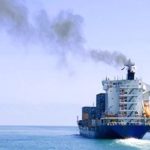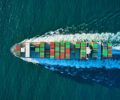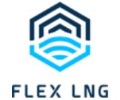Baseblue: “No Single Fuel Will Meet the Needs of the Whole Commercial Shipping Fleet”
 As the debate over the potential shipping decarbonization avenues is heating up, Hellenic Shipping News (www.hellenicshippingnews.com), interviewed Mr. Dave Gregory, Managing Director of North Europe for Baseblue. According to Mr. Gregory believes that the shipping industry will struggle to meet the 2030 mandates, set by the IMO. Baseblue was created through the merger of three leading bunkering companies Bunkernet, BMS United and SBI Bunkering BV, the company’s global network proactively fuels the shipping industry toward a better future.
As the debate over the potential shipping decarbonization avenues is heating up, Hellenic Shipping News (www.hellenicshippingnews.com), interviewed Mr. Dave Gregory, Managing Director of North Europe for Baseblue. According to Mr. Gregory believes that the shipping industry will struggle to meet the 2030 mandates, set by the IMO. Baseblue was created through the merger of three leading bunkering companies Bunkernet, BMS United and SBI Bunkering BV, the company’s global network proactively fuels the shipping industry toward a better future.
A recent study by Mckinsey concluded that the future of bunkering would involve three or even four different fuel types and corresponding supply chains. Do you share this view?
DG: There’s no one single fuel that will meet the needs of the whole commercial fleet. Each has different properties that will suit different vessel types and operational patterns.
Right now, the short-term availability of biofuels makes them particularly attractive to shipowners. Additionally, they are a drop-in fuel that involves little, if any, changes to infrastructure or engine performance, and they are available now in a growing number of ports.
However, biofuels are widely used by other industries, including land transport and aviation, which poses a competitive shipping risk. Unlike solar and wind, biomass is not immediately renewable; it takes time to grow the crops, trees and animals that are behind its production. This is why the future of bunkering involves a basket of fuel types for shipowners to choose from.

Mr. Dave Gregory, Managing Director of North Europe for Baseblue
Which fuels hold the most potential in the long term to lead shipping towards a net-zero future from 2050 onwards?
DG: Liquid fuels have a distinct advantage over gaseous ones because of greater fuel density and smaller storage requirements. But they can come at an energy penalty as fuels such as LNG and hydrogen need low-temperature, high-pressure storage. Some people are looking to hydrogen, as it does not contain carbon, but it is 14 times lighter than air, and as the smallest and lightest molecule, requires very specialist handling. Containment is an issue, and tanks empty very quickly if leaks occur – and while not harmful, it is an indirect greenhouse in its raw state.
Therefore, methanol is a strong contender in the long term, particularly if it is paired with carbon capture technology. CO2 capture is already widely used by industry, so if it can be captured onboard economically, it will protect the environment and create a revenue stream for shipowners.
Will the first cut-off date of 2030 be delayed further, or is there still enough time for shipping to adjust to the goal of reducing emissions?
DG: I think the industry will struggle to meet the IMO’s 2030 mandates. New fuel infrastructure takes time to build, and investment in new onboard technology can be difficult to justify for many older vessels. At some point, it’s just not financially viable for shipowners to make significant modifications to their vessels, and I anticipate that regulators will be forced to work with shipowners on what is feasible as we get closer to the deadline.
What are the main hurdles today when developing the necessary fuel technologies and supply chains?
DG: I see the main hurdle as regulatory uncertainty. This impacts investment in land-side infrastructure – production, distribution, and port-side bunkering. It also impacts shipowners’ ability to obtain finance for new ships or vessel upgrades. Clarity is required to ensure a level playing field going forward. There is a real opportunity at MEPC 80 in July to provide greater clarity for the industry as a whole.
One way of supporting the decarbonisation transition is carbon insetting. Carbon insetting differs from carbon offsetting in that carbon emissions are reduced directly within the shipping value chain rather than somewhere outside of and unrelated to the shipping industry.
Right now, alternative fuels are not available in all regions and differ in price, and not all vessels are ready to use these fuels; carbon insetting enables owners and operators to reduce emissions on vessels where it is practical to do so, regardless of location.
Spending money on non-shipping-related offsetting projects directs money out of the industry and in no way supports the technological shift required to advance carbon-neutral shipping solutions. A carbon insetting system allows the transfer of environmental benefits, decoupling carbon reduction from specific transport activity and enabling the greening of overall transport activity.
Insetting is an effective means of expediting the energy transition in shipping, which is currently blocked by price levels – fossil fuels remain cheaper than renewable fuels. The insetting system helps to close this price gap as the money from the tokens flows back into the shipping sector to ensure the continuing promotion and uptake of this clean fuel, essentially forming a new carbon economy.
Nikos Roussanoglou, Hellenic Shipping News Worldwide

 Hellenic Shipping News Worldwide Hellenic Shipping News Worldwide, Online Daily Newspaper on Hellenic and International Shipping
Hellenic Shipping News Worldwide Hellenic Shipping News Worldwide, Online Daily Newspaper on Hellenic and International Shipping






















 PG-Software
PG-Software